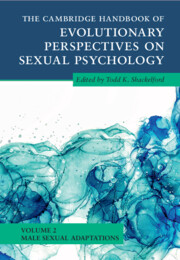Book contents
- The Cambridge Handbook of Evolutionary Perspectives on Sexual Psychology
- The Cambridge Handbook of Evolutionary Perspectives on Sexual Psychology
- Copyright page
- Contents
- Contributors
- Preface
- Part I Precopulatory Adaptations
- Part II Copulatory Adaptations
- Part III Postcopulatory Adaptations
- 14 Postejaculatory Adaptations to Self-Semen Displacement
- 15 Male Mate Retention
- 16 Shifts in Partner Attractiveness
- 17 Emotional Commitment in Men
- 18 Sexual Jealousy in Males
- 19 Men’s Attachment-Related Needs in the Sexual Arena
- 20 Paternal Care
- 21 Paternal Filicide
- Index
- References
18 - Sexual Jealousy in Males
The Evolution of a Specific Mechanism for Sexual Jealousy
from Part III - Postcopulatory Adaptations
Published online by Cambridge University Press: 30 June 2022
- The Cambridge Handbook of Evolutionary Perspectives on Sexual Psychology
- The Cambridge Handbook of Evolutionary Perspectives on Sexual Psychology
- Copyright page
- Contents
- Contributors
- Preface
- Part I Precopulatory Adaptations
- Part II Copulatory Adaptations
- Part III Postcopulatory Adaptations
- 14 Postejaculatory Adaptations to Self-Semen Displacement
- 15 Male Mate Retention
- 16 Shifts in Partner Attractiveness
- 17 Emotional Commitment in Men
- 18 Sexual Jealousy in Males
- 19 Men’s Attachment-Related Needs in the Sexual Arena
- 20 Paternal Care
- 21 Paternal Filicide
- Index
- References
Summary
Sexual jealousy arises in response to a perceived threat to a valued relationship with an individual, through perceptions or suspicions of a partner’s sexual infidelity. An evolutionary psychological perspective predicts that men are more sensitive to the sexual aspects of their partner’s infidelity than women, whereas women are more sensitive to the emotional aspects of their partner’s infidelity than men. This evolutionary perspective can be referred to as the sex-specific evolved jealousy mechanism (EJM). Many studies have verified the EJM. In this chapter, findings of studies on the EJM are discussed from two perspectives –the psychometric properties and participants’ and rivals’ characteristics – focusing on the findings from a meta-analysis in our laboratory (87 articles, k = 164, N = 125,698). Findings on the EJM are discussed from a psychometric perspective, focusing on (a) the rating methods of responses to a partner’s infidelity (i.e., forced-choice paradigm vs. continuous measures), (b) the validity of hypothetical infidelity scenarios used to have participants imagine a partner’s infidelity, (c) participants’ physiological responses to their partners’ infidelity, (d) participants’ response times to their partners’ infidelity, (e) participants’ recall performance for stimuli regarding infidelity, (f) participants’ responses to their partners’ infidelity under cognitive load, (g) heritability in behavior genetics, and (h) participants’ behaviors following their partners’ infidelity (e.g., morbid jealousy, violence, sexual coercion, and forgiveness). Findings on the EJM are discussed with respect to characteristics, focusing on (a) sexual orientation of participants, (b) participants who had nonmonogamous relationships, (c) children’s or siblings’ partners’ infidelity, and (d) participants’ digit ratio instead of sex. The EJM has been examined by many studies using various methods; however, conflicting findings have been reported. These differences seem to be caused by conflicting interpretations about the EJM and the rating methods of responses to infidelity.
Keywords
- Type
- Chapter
- Information
- Publisher: Cambridge University PressPrint publication year: 2022
References
- 4
- Cited by



